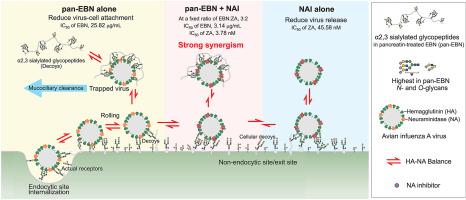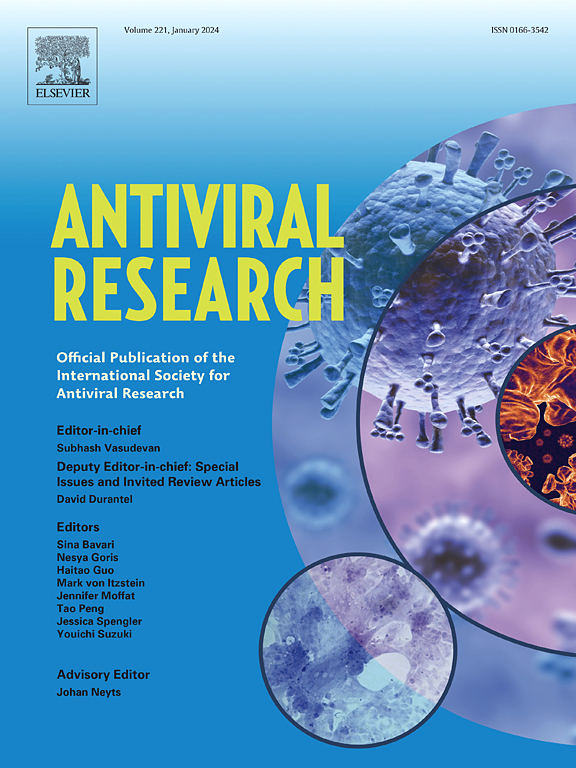Edible bird's nest: N- and O-glycan analysis and synergistic anti-avian influenza virus activity with neuraminidase inhibitors
IF 4.5
2区 医学
Q1 PHARMACOLOGY & PHARMACY
引用次数: 0
Abstract
Zoonotic avian influenza viruses have continued to infect people on occasion. During treatment, antiviral resistant viruses have occasionally emerged, highlighting the need for a novel strategy for treating human illness. After pancreatin treatment, edible bird's nest (EBN), swiftlet saliva consumed for health purposes, possesses anti-avian viral activity by inhibiting receptor-binding hemagglutinin (HA) activity. Glycan analysis revealed an abundance of α2,3Neu5Ac decoy receptors in pancreatin-treated EBN. Fucosylated tri-α2,3Neu5Ac tri-antennary N-glycans (N-35) and di-α2,3Neu5Ac core 2 O-glycans (O-15) are predominant, accounting for 53.46% and 44.66% of total N- and O-glycan amounts, respectively. Isobologram analysis revealed that the treated EBN had a strong synergistic effect with either oseltamivir carboxylate or zanamivir, a competitive inhibitor of receptor-destroying neuraminidases (NAs), against the avian H5N1 virus. Taken together, EBN has the potential to be developed as a food-derived avian viral trap to prevent and decrease avian virus infection as well as in combination with a viral releasing-NA inhibitor to increase therapeutic potency, reduce toxicity, delay resistance development, and potentially prevent pandemic onset.

食用燕窝:N-和 O-糖分析以及与神经氨酸酶抑制剂的协同抗禽流感病毒活性。
人畜共患的禽流感病毒仍不时感染人类。在治疗过程中,偶尔会出现对抗病毒药物产生抗药性的病毒,这凸显了治疗人类疾病的新策略的必要性。食用燕窝(EBN)是金丝燕的唾液,具有抗禽流感病毒活性,能抑制受体结合血凝素(HA)的活性。聚糖分析表明,EBN 中含有大量 α2,3Neu5Ac诱饵受体。其中主要是岩藻糖基化的三-α2,3Neu5Ac三触角N-聚糖(N-35)和二-α2,3Neu5Ac核心2 O-聚糖(O-15),分别占N-聚糖总量的53.46%和O-聚糖总量的44.66%。等全息图分析表明,EBN 与奥司他韦羧酸盐或扎那米韦(受体破坏神经氨酸酶(NAs)的竞争性抑制剂)对禽 H5N1 病毒有很强的协同作用。综上所述,EBN 有可能被开发为一种源自食物的禽类病毒捕获剂,用于预防和减少禽类病毒感染,并与病毒释放-NA 抑制剂结合使用,以提高疗效、降低毒性、延缓抗药性的产生,并有可能防止大流行的发生。
本文章由计算机程序翻译,如有差异,请以英文原文为准。
求助全文
约1分钟内获得全文
求助全文
来源期刊

Antiviral research
医学-病毒学
CiteScore
17.10
自引率
3.90%
发文量
157
审稿时长
34 days
期刊介绍:
Antiviral Research is a journal that focuses on various aspects of controlling viral infections in both humans and animals. It is a platform for publishing research reports, short communications, review articles, and commentaries. The journal covers a wide range of topics including antiviral drugs, antibodies, and host-response modifiers. These topics encompass their synthesis, in vitro and in vivo testing, as well as mechanisms of action. Additionally, the journal also publishes studies on the development of new or improved vaccines against viral infections in humans. It delves into assessing the safety of drugs and vaccines, tracking the evolution of drug or vaccine-resistant viruses, and developing effective countermeasures. Another area of interest includes the identification and validation of new drug targets. The journal further explores laboratory animal models of viral diseases, investigates the pathogenesis of viral diseases, and examines the mechanisms by which viruses avoid host immune responses.
 求助内容:
求助内容: 应助结果提醒方式:
应助结果提醒方式:


